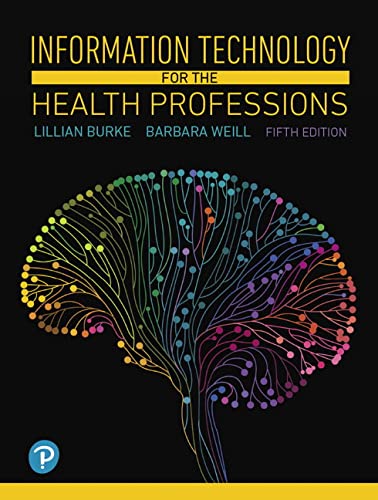Information Technology for the Health Professions 5th Edition by Lillian Burke, ISBN-13: 978-0134877716
[PDF eBook eTextbook]
- Publisher: Pearson; 5th edition (March 14, 2018)
- Language: English
- 352 pages
- ISBN-10: 0134877713
- ISBN-13: 978-0134877716
For courses in computers and technology in health care.
Innovative applications of health care IT in the health professions.
Information Technology for the Health Professions examines the myriad uses of computers and information technology in health care. Clear and comprehensive, it explores the applications of health care IT across health professions, including medical administration, telemedicine, public health, radiology, surgery, pharmacy, dentistry and rehabilitation. You’ll learn about rapid technological advances shaping health care delivery, federal laws impacting health care IT, and strategies for protecting patient privacy.
The 5th Edition explores innovations in health care IT. This includes teledentistry, robotic surgery, light imaging technology in radiology, and CRISPR, a technology improving gene editing.
Table of Contents:
1. An Introduction to Medical Informatics: Administrative Uses of Computers in the Medical Office
Chapter Outline
Learning Objectives
Clinical/Medical Informatics
The American Recovery and Reinvestment Act (ARRA), The Health Information Technology for Economic and Clinical Health Act (HITECH), and The Health Information Technology Decade
The Patient Protection and Affordable Care Act (ACA) (2010)
Administrative Applications of Computer Technology in the Medical Office
The Patient Information Form
The Paper Medical Record
The Electronic Medical Record
The Personal Health Record
The Electronic Health Record
The eHealth Exchange
The EHR and Big Data Analytics
Computer Information Systems in Health Care
Medical Office Administrative Software: An Overview
Coding and Grouping
Scheduling
Accounting
Insurance
Claims
Accounting Reports
Does Computerization Improve Patient Outcomes?
In the News
Chapter Summary
Key Terms
Review Exercises
Notes
Additional Resources
2. Telemedicine
Chapter Outline
Learning Objectives
Overview
Store-and-Forward Technology and Interactive Videoconferencing
Teleradiology
Telepathology
Teledermatology
Telecardiology
Teleneurology
Telestroke
Epilepsy
Parkinson’s Disease
E-mail and Digital Cameras in Teleneurology
Telepsychiatry
Remote Monitoring Devices
Telewound Care
Telehome Care
Telemedicine in Prison
Other Telemedicine Applications
The Telenurse
Smartphones and Tablet Computers
Is Telemedicine Effective?
Issues in Telemedicine
In the News
Chapter Summary
Key Terms
Review Exercises
Notes
Additional Resources
Related Websites
3. Information Technology in Public Health
Chapter Outline
Learning Objectives
Introduction
Definition
Social Inequality, Poverty, and Health
Using Computers to Study Disease
Statistics and Epidemics: A Historical Overview
The Emergence of Diseases in the Late 20th and Early 21st Centuries
AIDS
SARS
Ebola Virus
Antibiotic Resistance
MRSA
CRKP
NDM-1
Vector-Borne Diseases
West Nile Virus
Zika Virus
Using Information Technology to Track and Combat a 21st Century Epidemic: Cholera
Information Technology-Collection, Modeling, and Surveillance of Disease Agents
Computer Modeling of Disease: Health Statistics and Infectious Disease
Models of Infectious Disease Agent Study (MIDAS)
Climate Change: Global Warming
The Public Health Response to Hurricane Katrina
The BP Deepwater Horizon Oil Spill
A Note on the Earthquake, Tsunami, and Radiation Disaster in Japan
The Opioid Overdose Epidemic
Discussion
In the News
Chapter Summary
Key Terms
Review Exercises
Notes
Additional Resources
Related Websites
4. Information Technology in Radiology
Chapter Outline
Learning Objectives
Introduction
X-Rays
Ultrasound
Digital Imaging Techniques
Computed Tomography
Magnetic Resonance Imaging
Positron Emission Tomography
Single-Photon Emission Computed Tomography Scans
Functional Near-Infrared Spectroscopy (fNIRS)
Bone Density Tests
Other Imaging Technology
Nanotechnology
Computer-Aided Detection
Picture Archiving and Communications Systems
Interventional Radiology: Bloodless Surgery
The Dangers of Medical Radiation
In the News
Chapter Summary
Key Terms
Review Exercises
Notes
Additional Resources
Related Websites
5. Information Technology in Surgery-The Cutting Edge
Chapter Outline
Learning Objectives
Overview
Computer-Assisted Surgery
Computer-Assisted Surgical Planning
Minimally Invasive Surgery
Computer-Assisted Surgery and Robotics
ROBODOC, AESOP, ZEUS, da Vinci, MINERVA, NeuroArm, and Other Robotic Devices
Issues in Robotic Surgery
Augmented Reality
Telepresence Surgery
NASA Extreme Environment Mission Operation
The Operating Room of the Future
Lasers in Surgery
Discussion and Future Directions
Nanotechnology
Conclusion
In the News
Chapter Summary
Key Terms
Review Exercises
Notes
Additional Resources
Related Websites
6. Information Technology in Pharmacy
Chapter Outline
Learning Objectives
Overview
The Food and Drug Administration
Uncertified Medicines
Biotechnology and the Human Genome Project
Rational Drug Design
Bioinformatics
The Human Genome Project
Developments in Biotechnology
Computer-Assisted Drug Trials
Computer-Assisted Drug Review
The Computerized Pharmacy
Computers and Drug Errors
The Automated Community Pharmacy
Automating the Hospital Pharmacy
The Hospital Pharmacy-Robots and Barcodes
Point-of-Use Drug Dispensing
Computerized IVS and Barcodes
Radio Frequency Identification Tags
Telepharmacy
Drug Delivery on a Chip
Nanotechnology and Pharmacy
The Impact of Information Technology on Pharmacy
In the News
Chapter Summary
Key Terms
Review Exercises
Notes
Additional Resources
7. Information Technology in Dentistry
Chapter Outline
Learning Objectives
Overview
Education
Administrative Applications
The Electronic Dental Chart
Demographics and the Transformation of Dentistry
Computerized Instruments in Dentistry
Endodontics
Periodontics
Cosmetic Dentistry
Diagnosis and Expert Systems
Diagnostic Tools
X-Rays
Digital Radiography
Cone Beam Computed Tomography Scanner
Electrical Conductance
Other Methods
Light Illumination
Lasers in Dentistry
Minimally Invasive Dentistry
Surgery
Teledentistry
In the News
Chapter Summary
Key Terms
Review Exercises
Notes
Additional Resources
Related Websites
8. Informational Resources: Computer-Assisted Instruction, Expert Systems, Health Information Online
Chapter Outline
Learning Objectives
Overview
Education
The Visible Human Project
Computer-Assisted Instruction
Simulation Software
Virtual Reality Simulations
Patient Simulators
Distance Learning
Decision Support: Expert Systems
Health Information on the Internet
Medical Literature Databases
E-mail
Self-Help on the Web
Support Groups on the Web
Judging the Reliability of Health Information on the Internet
Health-Related Smartphone and Tablet Computer Apps
Computers and Psychiatry
Conclusion
In the News
Chapter Summary
Key Terms
Review Exercises
Notes
Additional Resources
Related Websites
9. Information Technology in Rehabilitative Therapies: Computerized Medical Devices, Assistive Technology, and Prosthetic Devices
Chapter Outline
Learning Objectives
Overview
Computerized Medical Instruments and Devices
Computerized Devices in Optometry/Ophthalmology
Assistive Devices
Augmentative Communication Devices
Electronic Aids to Daily Living
Prosthetic Devices
Computerized Functional Electrical Stimulation Technology
Risks Posed by Implants
Computers in Rehabilitative Therapies
Conclusion
In the News
Chapter Summary
Key Terms
Review Exercises
Notes
Additional Resources
Related Websites
10. Security and Privacy in an Electronic Age
Chapter Outline
Learning Objectives
Security and Privacy-An Overview
Threats to Information Technology
Computer Technology and Crime
Security
Privacy
Databases
Government Databases
Private Databases
Databases and the Internet
Privacy, Security, and Health Care
Health Insurance Portability and Accountability Act of 1996 (HIPAA) and HITECH
Privacy of Medical Records Under HIPAA, HITECH, and the USA Patriot Act
Telemedicine and Privacy
E-mail and Privacy
Privacy and Genetic Information
Privacy and Electronic Health Records
In the News
Chapter Summary
Key Terms
Review Exercises
Notes
Additional Resources
Related Websites
Lillian Burke is co-author of Information Technology for the Health Professions (Pearson 1999-2018) and MediSoft Made Easy: A Step-by-Step Approach (Pearson 2004, 2011). Lillian teaches in the fields of business education, medical technology, computer science, accounting and marketing. She is a teacher in the Essex County Vocational and Technical School District. She has taught full time at Berkeley College and Middlesex County College and as an adjunct professor of business technology, business law and computer science at various institutions, including Berkeley College, Middlesex County College and Pace University. Lillian received her MA, School of Education, Health, Nursing, and Arts from New York University; a BBA in Business Education from Pace University; and an AAS, Executive Secretary Program, Nassau Community College. Additionally, she holds a Supervisor’s Certification from Kean University for the New Jersey Department of Education; a New Jersey State Certification for Teacher of Data Processing; a New Jersey State Certification for Teacher of Secretarial Studies; a New York State Teaching Certification; and a Mini Medical School Certification from the University of Medicine and Dentistry of New Jersey-Robert Wood Johnson Medical School.
Dr. Barbara Weill is co-author of Information Technology for the Health Professions (editions 1-5) and MediSoft Made Easy: A Step-by-Step Approach (editions 1 and 2). Retired now, she taught as an adjunct professor of sociology, history and computer science at various institutions, including Essex County College, Somerset County College (now Raritan Valley Community College), Rutgers College and Middlesex County College. She received a BA in sociology from City College of New York (1968), an MA and PhD in sociology from The Graduate Faculty of Political and Social Science of the New School for Social Research (1970 and 1977) and an associate degree in computer information systems from Middlesex County College (1989).
What makes us different?
• Instant Download
• Always Competitive Pricing
• 100% Privacy
• FREE Sample Available
• 24-7 LIVE Customer Support






Reviews
There are no reviews yet.